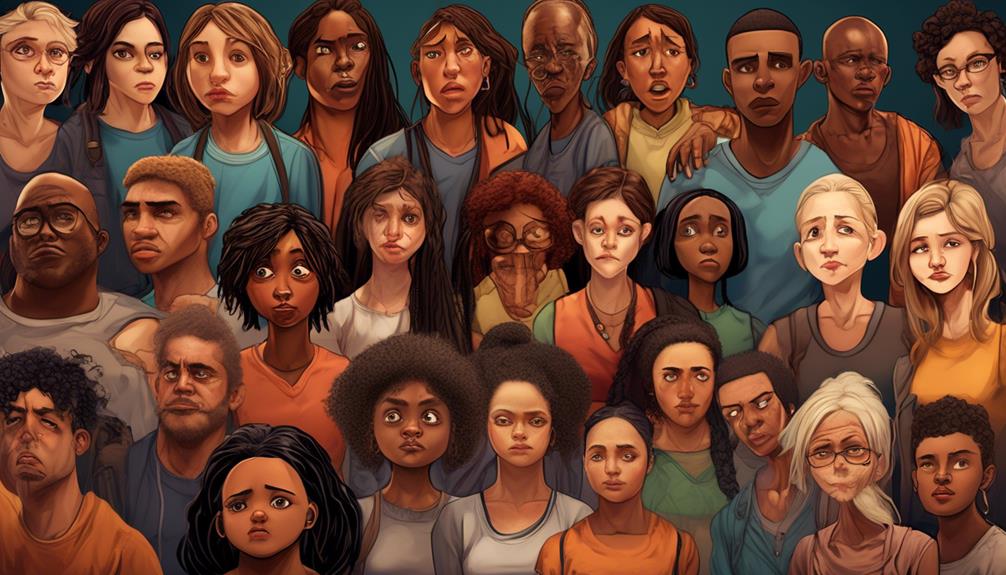When examining how BPD characters are portrayed in literature and films, we discover a intricate mix of emotions and experiences that reflect the complexity of the human mind. These characters act as reflections, emphasizing the subtleties of mental health challenges and how society views them.
By exploring the nuances of Borderline Personality Disorder through various narratives, we are confronted with a glimpse of the intricate dance between inner turmoil and external perceptions.
Join us as we dissect the impact of BPD characters on storytelling and the broader conversation surrounding mental health representation in media.
Key Takeaways
- Media portrayal influences audience perceptions and challenges stereotypes.
- BPD characters reflect real struggles, fostering empathy and reducing stigma.
- Fictional traits like impulsivity and fear of abandonment shed light on BPD challenges.
- Representation sparks conversations, shapes attitudes, and promotes mental health awareness.
Portrayal of Bpd Characters in Media
In examining the portrayal of BPD characters in media, we find a landscape that often oscillates between accuracy and dramatization, impacting how the audience perceives and understands individuals with Borderline Personality Disorder. Characters with BPD traits are frequently depicted as individuals struggling with intense emotions, impulsive behaviors, and challenges in forming stable relationships. While such portrayals can help shed light on the complexities of BPD and provide representation for those with similar experiences, they can also perpetuate stereotypes and misconceptions about the disorder.
Fictional characters with BPD traits play a crucial role in shaping public perceptions of mental health, influencing attitudes towards individuals grappling with their identity and emotions. When crafted authentically, these characters have the potential to increase empathy, reduce stigma, and initiate important conversations about mental health. However, the challenge lies in striking a balance between realism and entertainment value, steering clear of harmful stereotypes, ensuring accuracy in depictions, and addressing ethical considerations surrounding the portrayal of BPD in media.
Impact on Mental Health Awareness

Fictional characters portraying Borderline Personality Disorder have the potential to significantly impact mental health awareness and perceptions within society. These characters serve as mirrors reflecting various aspects of living with BPD, shedding light on the challenges individuals with this condition face. By showcasing the complexities of BPD through narratives, media representations can foster empathy and understanding among audiences. Moreover, these portrayals contribute to reducing the stigma surrounding mental health by humanizing individuals struggling with BPD.
Through the representation of characters with BPD, viewers are offered a glimpse into the internal struggles and external manifestations of the disorder. This exposure not only provides a sense of validation and recognition for those grappling with similar experiences but also initiates important conversations about mental health. By engaging with these fictional depictions, audiences can gain insights into the intricacies of BPD, leading to increased awareness and potentially encouraging further dialogue on the subject. Ultimately, the portrayal of BPD in media can play a vital role in shaping societal attitudes towards mental health.
Analysis of Character Traits
Analyzing the character traits of individuals with BPD in fictional representations reveals common themes of impulsivity, self-destructive tendencies, intense emotions, identity struggles, fear of abandonment, and isolation. These traits are often depicted in fictional characters like Harley Quinn, Anakin Skywalker, Jessica Jones, Elsa, and Rebecca Bunch. The table below provides a visual representation of how these traits manifest in these characters:
| Fictional Characters | BPD Traits | Examples |
|---|---|---|
| Harley Quinn | Impulsive behavior, self-destructive tendencies | Substance abuse, intense passion |
| Anakin Skywalker | Intense emotions, struggles with identity | Fear of abandonment, self-destructive tendencies |
| Jessica Jones | Fear of abandonment, isolation | Intense emotions, self-destructive tendencies |
These characters demonstrate the complex interplay of traits associated with BPD, offering insight into the challenges faced by individuals dealing with the disorder. Through these portrayals, audiences can gain a better understanding of the nuanced experiences and behaviors of people with BPD.
Representation in Popular Culture

Exploring the portrayal of Borderline Personality Disorder (BPD) in popular culture provides valuable insights into societal perceptions and awareness surrounding this complex mental health condition. When examining fictional characters with borderline personality, we often encounter individuals who struggle with relationships, intense emotions, abandonment issues, and a turbulent sense of identity and true self. These characters diagnosed with BPD are depicted as relatable figures facing a difficult time dealing with their often intense and overwhelming feelings.
Here are some key points to consider:
- Rich Character Depth: Fictional portrayals offer a nuanced look into the inner world of individuals with BPD, showcasing the depth of their emotional experiences.
- Challenges with Relationships: These characters frequently grapple with maintaining stable and healthy relationships due to their emotional volatility and fear of abandonment.
- Struggles with Self-Identity: The journey to uncovering one's true self amidst the chaos of BPD is a central theme in many representations.
- Lack of Control: Characters often depict the struggle to regulate their emotions and impulses, highlighting the challenges of managing BPD in everyday life.
Significance of BPD Characters
Considering the multifaceted nature of Borderline Personality Disorder (BPD) characters in popular culture, their significance lies in fostering understanding and empathy towards individuals grappling with the complexities of this mental health condition. Fictional characters with borderline personality traits serve as powerful vehicles for portraying mental health issues authentically. These characters offer insights into the challenges of BPD, showcasing fluctuating emotions, struggles with identity, and intricate relationship dynamics.
Moreover, the accurate portrayal of BPD characters in movies and TV shows contributes to reducing stigma around the disorder. By depicting the nuances of BPD, these characters help spark conversations and increase awareness about the condition. However, it's essential to note that the accuracy in these portrayals varies, influencing public perception and understanding of BPD. By providing representation and shedding light on the struggles faced by individuals with BPD, these characters play a crucial role in promoting empathy, initiating discussions, and ultimately fostering a more inclusive and compassionate society.
Frequently Asked Questions
Which Fictional Character Has Bpd?
We believe that identifying fictional characters with Borderline Personality Disorder can be complex.
When exploring this topic, it's crucial to consider the nuances and depth of the characters' behaviors and emotions.
By examining traits such as emotional intensity, impulsivity, fear of abandonment, and struggles with identity, we can gain valuable insights into how BPD is portrayed in popular media.
This analysis helps us understand the complexities of mental health representation in storytelling.
Why Is BPD Life Expectancy 27?
The misconception about BPD life expectancy being 27 arises from misinterpretation. Studies show an average reduction of 8 to 10 years due to factors like suicide and substance abuse.
Early intervention, proper diagnosis, and support play vital roles in improving outcomes. Addressing stigma and ensuring access to quality care are key for enhancing well-being and longevity for individuals with BPD.
It's crucial to promote awareness and understanding to support those affected by the condition.
What Does a BPD Episode Look Like?
During a BPD episode, we navigate a tumultuous landscape of intense emotions, erratic impulses, and unstable sense of self. The experience can feel like being caught in a storm of fear, emptiness, and chaos.
Our frantic attempts to avoid abandonment often lead to turbulent relationships and risky behaviors. Regulating emotions becomes a monumental task, as anger, sadness, and anxiety overwhelm us.
Each episode is a battle against ourselves, fought on the battlefield of our minds.
What Are the 4 Types of Bpd?
The four types of Borderline Personality Disorder (BPD) are Discouraged Borderline, Petulant Borderline, Impulsive Borderline, and Self-Destructive Borderline.
Each type presents with unique characteristics and behaviors. Discouraged Borderline individuals struggle with feelings of inadequacy and helplessness.
Petulant Borderline individuals exhibit angry and resentful behaviors in response to criticism.
Impulsive Borderline individuals engage in reckless activities.
Self-Destructive Borderline individuals may harm themselves or engage in suicidal behaviors to cope with emotional distress.
Conclusion
In conclusion, the portrayal of BPD characters in media has had a significant impact on mental health awareness. Through their complex and relatable struggles, these characters have helped shed light on important themes surrounding abandonment, trauma, and the search for love and acceptance.
Their representation in popular culture serves as a reminder of the importance of understanding and empathy towards individuals grappling with BPD. Let's continue to strive for greater awareness and support for those facing similar challenges.









